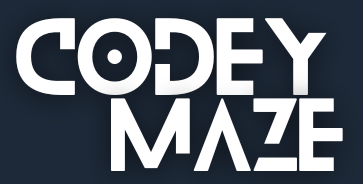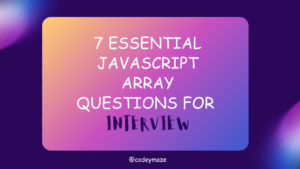Let’s learn some JavaScript questions which you should know before you appear in your interview. First of all let’s see what is JavaScript?
JavaScript is a high-level, versatile programming language widely used for creating interactive and dynamic content on websites. It is primarily a client-side language that runs in web browsers to enhance user interfaces and experiences, but it can also be used on the server side with environments like Node.js.
Here are some JavaScript MCQ questions with answers that will help you to prepare for your next interview.
Multiple Choice Questions with Answers
Q1. Which of the following is not a reserved word in JavaScript?
- interface
- throws
- program
- short
View Answer
program
Q2. In JavaScript the x===y statement implies that
- Both x and y are equal in value, type and reference address
- Both are x and y are equal in value only
- Both are equal in the value and data type
- Both are not same at all
View Answer
Both are equal in the value and data type
Q3. What will typeof NaN return?
- number
- NaN
- undefined
- object
View Answer
number
Q4. What is the output of the following code?
console.log(typeof null);- null
- undefined
- object
- number
View Answer
object
Q5. What will NaN === NaN evaluate to in JavaScript?
- True
- False
- Undefined
- None of the above
View Answer
False
Q6. Which of the following is not a valid JavaScript variable name?
- _myVar
- my-var
- $myVar
- myVar1
View Answer
my-var
Q7. What is the output of the following code?
function test() {
console.log(this);
}
test();- undefined
- null
- Window object (in browsers)
- test function
View Answer
Window object (in browsers)
Q8. Which of the following method is used to merge two arrays into one?
- arr1 + arr2
- arr1.concat(arr2)
- arr1.add(arr2)
- arr1.merge(arr2)
View Answer
arr1.concat(arr2)
Q9. What is the use of Promise.all method?
- To run multiple promises sequentially
- To wait until all promises are either resolved or rejected
- To run multiple promises and return the result of the first resolved promise
- To handle the first rejected promise only
View Answer
To wait until all promises are either resolved or rejected
Q10. What will be the output of the following code?
let a = [1, 2, 3];
let b = a;
b.push(4);
console.log(a);- [1, 2, 3]
- [1, 2, 3, 4]
- undefined
- error
View Answer
[1, 2, 3, 4]
Q11. What is the purpose of the bind method in JavaScript?
- To call a function with a specified this context
- To create a new function with a specified this context and arguments
- To call a function immediately with a specified this context
- To add properties to an object
View Answer
To create a new function with a specified this context and arguments
Q12. What does the async keyword do when applied to a function?
- It turns the function into a generator function
- It makes the function execute synchronously
- It allows the function to return a promise and to use await within it
- It allows the function to be executed only in an async context
View Answer
It allows the function to return a promise and to use await within it
Q13. What will be the output of the following code?
console.log("5" + 3);- 8
- 53
- error
- undefined
View Answer
53
Q14. What will be the output of the following code?
let a = 10;
(function() {
console.log(a);
let a = 20;
})();- 10
- 20
- undefined
- ReferenceError
View Answer
ReferenceError
Q15. What is the output of the following code?
const obj = {
a: 1,
b: 2,
c: 3
};
console.log(Object.keys(obj).length);- 1
- 2
- 3
- 4
View Answer
3
Q16. Which of the following is true about the setTimeout function?
- It immediately executes the specified function
- It delays the execution of the specified function until the browser is idle
- It executes the specified function after the given delay
- It repeatedly executes the specified function at fixed intervals
View Answer
It executes the specified function after the given delay
Q17. What will be the output of the following code?
function foo() {
return {
bar: "hello"
};
}
console.log(foo().bar);- hello
- undefined
- null
- Error
View Answer
hello
Q18. Which of the following statements is correct about async functions?
- async functions return a promise
- async functions must contain an await statement
- async functions cannot be used as constructors
- Both A and C
View Answer
Both A and C
Q19. What is the main purpose of the Event Loop in JavaScript?
- To execute synchronous code
- To handle asynchronous callbacks
- To manage memory allocation
- To parse JavaScript code
View Answer
To handle asynchronous callbacks
Q20. What is the output of the following code?
const a = [];
const b = a;
b.push(1);
console.log(a === b);- false
- true
- undefined
- Error
View Answer
true
Q21. Which of the following is not a primitive data type in JavaScript?
- String
- Number
- Boolean
- Object
View Answer
Object
Q22. What will be the output of the following code?
var a = [1, 2, 3];
a[10] = 99;
console.log(a.length);- 3
- 4
- 11
- 10
View Answer
11
Q23. What does the isNaN() function do?
- Checks if a value is null
- Checks if a value is not a number
- Checks if a value is a number
- Checks if a value is NaN
View Answer
Checks if a value is not a number
Q24. What will be the output of the following code?
function foo() {
return
{
bar: "hello"
};
}
console.log(foo());- undefined
- { bar: “hello” }
- null
- Throws a syntax error
View Answer
undefined
Q25. What will be the output of the following code?
let a = 1;
let b = 2;
[a, b] = [b, a];
console.log(a, b);- 1 2
- 2 1
- undefined undefined
- 1 undefined
View Answer
2 1
Q26. Which of the following number object function returns the value of the number?
- toString()
- valueOf()
- toLocaleString()
- toValue()
View Answer
valueOf()
Q27. Which one of the following operator is used to check weather a specific property exists or not?
- exists
- within
- includes
- in
View Answer
in
Q28. Which of the following is a ternary operator
- :
- ?
- ||
- |
View Answer
?
Q29. Which one of the following is not considered as “statement” in the JavaScript?
- use strict
- debugger
- if
- with
View Answer
use strict
Q30. In JavaScript, what kind of scoping is used?
- Literal scoping
- Segmental scoping
- Lexical scoping
- Default scoping
View Answer
Lexical Scoping



